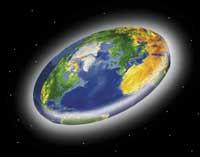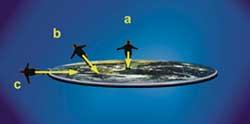What if the Earth were flat?

From the individual point of view, moreover, it is not so difficult. From a large plain or open sea, seen to one side or the other, you can see a flat area. Inexhaustible. Instinctively, this flat geometry is easily acceptable.
But flat geometry brings some questions, where does that plain end? Does it extend to infinity? It will have to end, if we see that the Sun rises in the East and sets in the West. The Earth is finite, it seems to be finished.
In many ancient civilizations it was considered to be disk shaped, so they had solved the problem of the Sun and with this explanation was maintained what intuition had promised: The earth is flat and has a final edge. The most daring did not want to go to that arista either, since there was a great danger of falling.
Do not go against. Let us accept the idea of the Flat Earth and that we are inhabitants of an album. How would everything that surrounds us be? It is not the same as what we see now, in no case.
The most significant change would be gravity. Although the mass is the same, it would be distributed in another way, and in addition to the mass, gravity would be divided in another way, in short, because from where the mass is makes strength. In the spherical earth gravity is the same in all points of the terrestrial surface, but in the discoidal form it would vary from one point to another.
Imagine… Imagine that each side of the album is a hemisphere, with the equator at the edge and the pole at the center. If we were at a pole, at the center of one of the faces of the disk, most of the matter on Earth would not be under us. Most of the matter, so to speak, would be in our environment, however, in the feet. Matter would attract us at the same time in all directions, so that the influence of matter on one side would compensate for that of another. However, in descending direction, we would notice a weak force, although directly below we would have very little matter.
According to this, if we were in the middle of the disk, the gravity would be very low and to float in the air would be very little. Like astronauts, we would live almost without gravity.
Global: we wouldn't weigh almost anything. But this brooch would only last in the centers of the disk, that is, in the poles. If we started traveling to the equator we would have to take more weight.
The wrong world
As we move away from the center, most of the matter on the planet will leave behind. Therefore, gravity would not only pull down but back, that is, force would not be vertical down, but inclined. Well said, the force would not be perpendicular to the terrestrial surface.

On the way away from the Polo, we would notice that the force that would pull us changes, the farther away from the center, the stronger and inclined it would be. In practice, from our point of view, we would feel as if we were ascending for an increasingly hard slope.
For example, in Euskal Herria the effect of gravity would be very evident: regardless of whether it is mountains, the Basque Country itself would be a great slope; in the lower part Baiona and in the upper part Tudela.
For the same reason, traveling on the edge of the disc would be like climbing a mountain. The slope, increasingly hard, and the equator itself, would be the top of the mountain.
A hard life
Surely, if things are so, the Basques would be perfectly adapted to live on the slope… all this if there were human beings.
And it is that the consequences of the Earth being flat go beyond; depending on the gravity and rotation of the planet, many other characteristics would change, for example, the atmosphere, and therefore the climate, and therefore the ecosystems, and therefore the species, and the man, etc.
Gravity on Earth in the form of a disk would have a strange influence. For example, the streams would fall to the center of the disk, and perhaps in the center of it would form an ocean covered with water vapor. And many other things would also tend to fall toward the center.

Just as the stones fall little by little on the slopes of the mountains, they would fall towards the center of the planet, with much acceleration in the corners and more slowly in the interiors. The erosion caused by rivers would also contribute to this process, in which stones and minerals would gradually accumulate in the center. Consequently, accumulating the matter in the center for thousands of years, the whole planet would be rounded up and gravity would tend to match it in all places.
It would become a spherical planet. No wonder, because it is the most stable aspect. That is why the planets and satellites we see from Earth are round.





